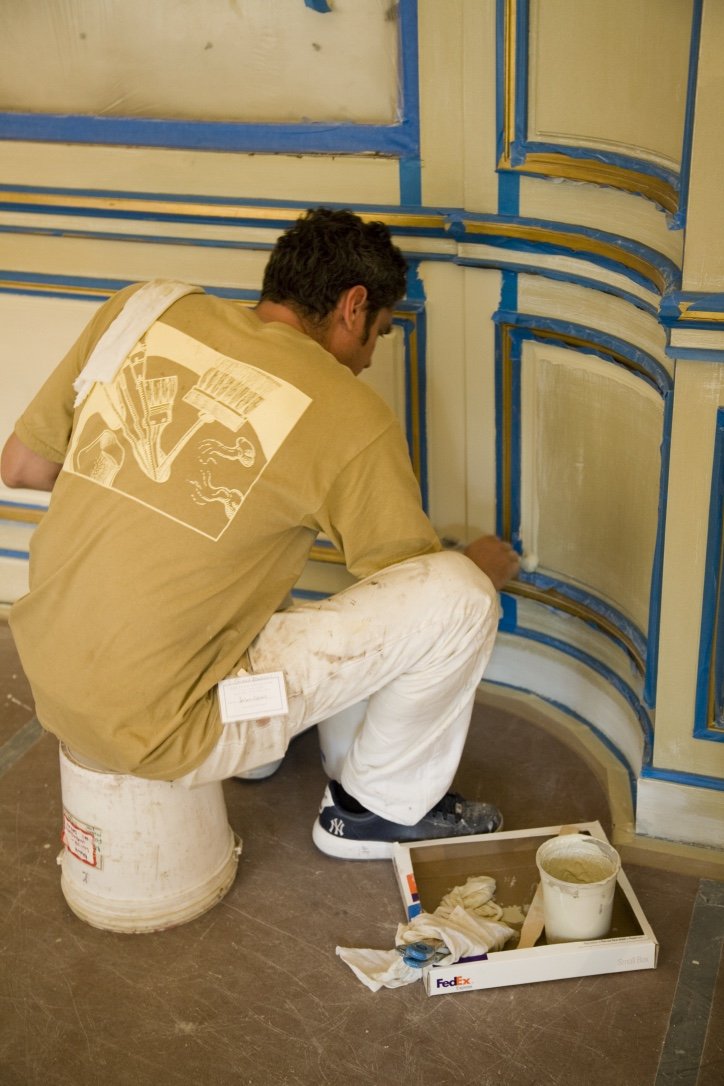The Fragonard Room at The Frick Collection Historic Case Study
The Fragonard Room at The Frick Collection
Historic Case Study
Project /
The Fragonard Room at The Frick Collection, New York
Client /
The Frick Collection
DESIGN BRIEF
At the heart of The Frick Collection lies the magnificent Fragonard Room, a celebration of 18th-century artistry and decorative opulence. By the early 2000s, this iconic space, adorned with Jean Honoré Fragonard's exquisite "The Progress of Love" series, showed clear signs of aging. Cracks had developed in the plaster, finishes had dulled, and the painted surfaces bore the wear of time. The restoration project was undertaken by Grand Illusion, the prestigious decorative arts company owned by renowned master craftsman Pierre Finkelstein. Under Pierre's company, Jason led the team tasked with preserving this historic treasure for future generations.
Originally commissioned to adorn a private Parisian townhouse in the 1770s, the room represents more than just a gallery—it is an immersive work of art. Over the centuries, it was carefully adapted and reassembled within The Frick Collection, where it serves as a dramatic focal point. This restoration project required not just technical expertise, but a deep understanding of the room's historical significance and its role in the museum's identity.
process
The restoration demanded an unprecedented level of precision and care. Working within a museum environment required a highly controlled approach to protect both the room's priceless artworks and adjacent spaces. We implemented sophisticated air scrubbing systems to maintain pristine conditions and prevent contamination, while adhering to a strict schedule of daily quality checks.
During our initial assessment, we discovered significant sections of loose plaster on the ceiling, hidden beneath surface imperfections. This unexpected challenge expanded our scope but demanded swift, decisive action. Our team developed custom formulations of paints and glazes to recreate an authentic 18th-century patina, carefully layering translucent glazes to achieve the depth and warmth characteristic of historic interiors.
The balance between aesthetic cohesion and modern conservation requirements posed a unique challenge. Every decision needed to align with the room's original Rococo charm while meeting the durability and safety standards of a 21st-century museum setting. This delicate balance influenced everything from material selection to application techniques, ensuring each element contributed to both the room's preservation and its visual harmony.
The restoration presented a unique challenge that exemplified our dedication to historical accuracy and collaborative craftsmanship. Every step of the process was meticulously coordinated with the museum's curator, ensuring each decision aligned with the building's rich heritage. Our specialist team created numerous samples of finishes and techniques, each carefully formulated to match the original aesthetic while providing modern durability. These samples underwent rigorous review processes, with the curator's expertise guiding our selection of materials and application methods. Through close collaboration, detailed documentation, and multiple sampling phases, we successfully restored the spaces to their former glory while maintaining their historical integrity. This project exemplifies our commitment to preserving our architectural heritage through thoughtful, curator-led restoration.
"The Fragonard Room restoration exemplifies the delicate balance between preservation and revival. Each brushstroke, each layer of glaze, each restored detail tells the story of not just what we were preserving, but why. In historic restoration, we aren't just conservators of technique - we're guardians of cultural memory." - Jason ebers
PROJECT OUTCOME
Today, the Fragonard Room stands as a testament to the marriage of historic preservation and modern craftsmanship. The restored space captures the soft, lustrous finish of its original era while meeting contemporary conservation standards. New painted surfaces blend seamlessly with existing décor, creating an authentic and cohesive environment that transports visitors to an era of unparalleled elegance.
"Jason Ebers demonstrated a sophisticated ability to adapt modern materials to mimic the appearance of historic techniques. His use of acrylic paints to replicate the look of traditional glue-based paints was masterful." - Conservator at The Frick Collection. This endorsement reflects not just the technical achievement, but the artistic sensitivity brought to every aspect of the restoration.
The project represents more than just a restoration, it exemplifies the level of masterful craftsmanship and commitment to preserving cultural heritage that defines our approach to decorative artistry. The Fragonard Room now continues its role as a dramatic focal point within The Frick Collection, where art, architecture, and craftsmanship blend into a unified masterpiece.







